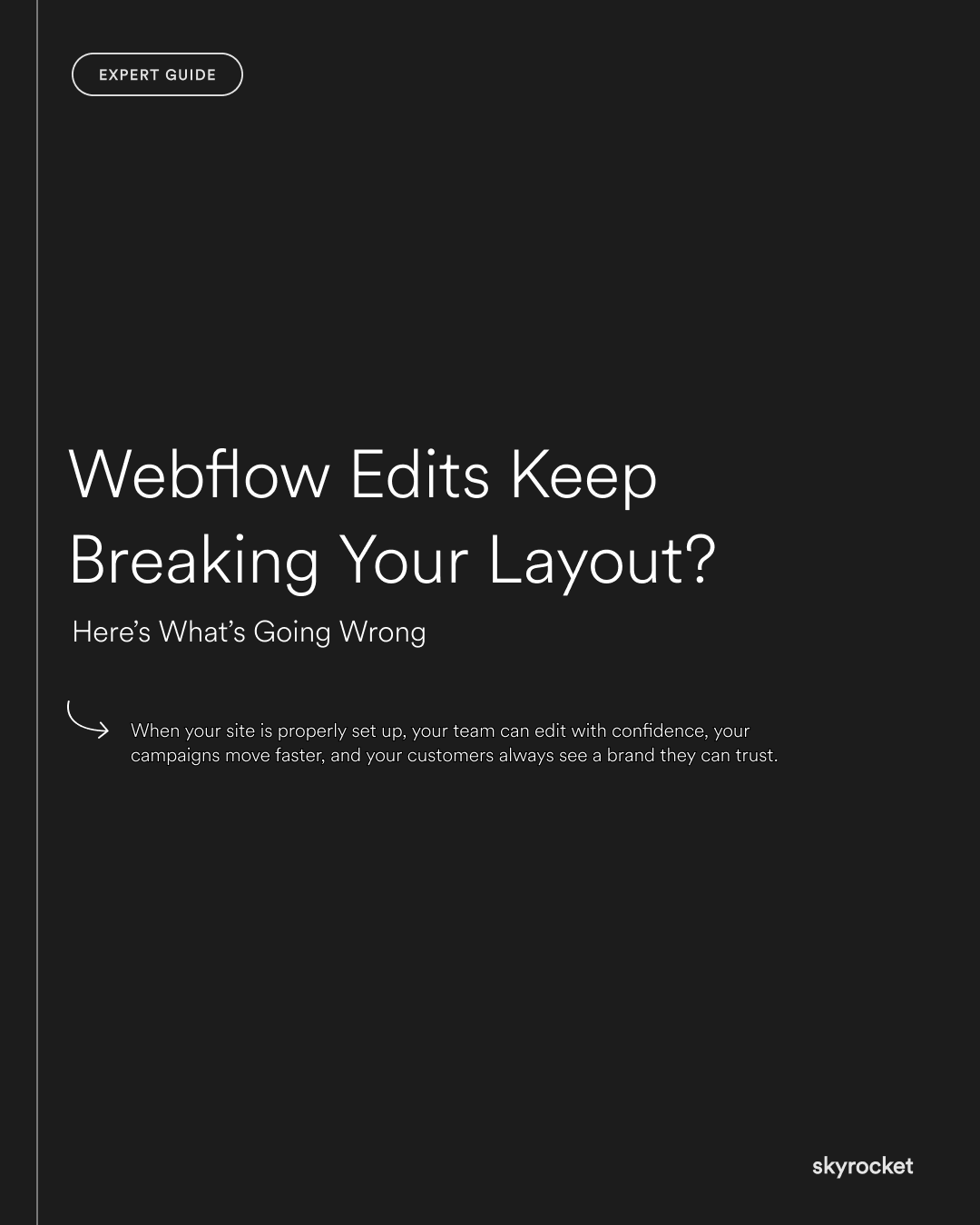Picture this: your marketing team updates a headline in Webflow, and suddenly the hero banner collapses on mobile. A product manager swaps out a photo and the layout of your entire grid shifts. What should be a quick, harmless edit turns into an urgent call to your developer. Hours are lost, campaigns stall, and your customers are left staring at a website that looks unprofessional.
These layout breakages are not just annoying. They can cost you sales, slow your growth, and damage the trust customers have in your brand. Every time your site is offline or looking broken, you are sending a signal that your business might not be as polished as you want it to be. And if every small change means going back to your developer, the efficiency of your entire team takes a hit.
The good news? This is not a Webflow problem. It is a setup problem. And it can be fixed.
Why This Matters for Business Outcomes
Webflow is designed to give you control. The promise is that once your site is built, your team should be able to update it easily. Headlines, photos, blog posts, campaign pages; all of these should be editable without worry.
When that promise fails, the business impact is immediate:
- Lost sales: A broken layout confuses customers, drives them away, and lowers conversions.
- Slower growth: Marketing teams cannot move fast if they need a developer for every minor update.
- Damaged trust: A site that looks messy reflects poorly on your brand’s reliability.
- Reduced efficiency: Your people spend more time firefighting than focusing on growth.
This is not about pixels or code. It is about whether your website is helping or holding back your business.
Key Tip: The problem isn't Webflow, it's the build.
Think of it like a house. If the foundations are shaky, it does not matter how carefully you decorate. Cracks will show. A well-structured Webflow build acts like a strong foundation. You can repaint walls, move furniture, and hang new art without worrying the house will collapse.
What’s Going Wrong: The Five Common Culprits
1. Your Site Was Built Without Reusable Styles
If your designer created one-off styles for every heading, button, and block, the site may look fine at launch. But the moment you try to edit it, things fall apart.
Imagine a business card where every letter is hand-placed. Change one word and the whole layout shifts. That is what happens when Webflow builds lack reusable classes.
Business impact: Every minor change becomes risky, meaning you waste time and money fixing what should be simple.
Fix: A properly set up Webflow site uses global styles and reusable components. Update one style, and it cascades smoothly across the site.
2. There’s No Clear Content Management System (CMS)
Webflow’s CMS is powerful, but many sites do not use it properly. If your blog, product list, or team page is made up of static pages instead of CMS-driven collections, every update means manual edits. That is when mistakes and layout breaks creep in.
Business impact: Instead of scaling smoothly, you end up copying and pasting. More content means more problems.
Fix: A CMS-driven build means you only edit structured fields like titles, images, or categories while the layout stays intact.
3. The Site Isn’t Built for Mobile First
Too many builds look great on desktop but fall apart on mobile. If your team edits content without a mobile-first foundation, layouts can collapse.
Business impact: With more than half of your customers browsing on mobile, a broken mobile layout is a direct hit on sales and trust.
Fix: A professional build considers mobile layouts from the start. Edits are tested across breakpoints so nothing shifts unexpectedly.
4. No Guardrails for Non-Technical Editors
If your Webflow Editor dashboard feels like a maze, it is easy for your team to make the wrong change. Without clear guardrails, an eager marketer can drag the wrong block and accidentally break an entire section.
Business impact: Instead of empowering your team, your site scares them. They hesitate to edit, or worse, edit carelessly.
Fix: A well-structured Webflow site has a clean editor view. Non-technical users only see what they need, reducing risk and boosting confidence.
5. The Build Was Rushed or Done by a Generalist
Not all Webflow builds are equal. A rushed freelancer or an agency that does not specialise in Webflow may deliver something that looks good on the surface but is fragile underneath.
Business impact: You end up paying twice. First for the build, then again for endless fixes, or even a full rebuild.
Fix: The strongest investment is in a properly structured build from the start. It saves years of frustration and wasted spend.
A Tangible Example
Take a mid-sized retailer in Auckland. Their marketing team needed to swap out homepage banners weekly to promote new deals. Each time, the layout broke on mobile, leaving buttons overlapping and text unreadable.
Customers complained, conversions dipped, and developers were pulled in for emergency fixes.
The root cause? Their site had no reusable classes or CMS setup. Every banner was hard-coded. A rebuild with proper structure meant the team could change banners in minutes, with zero risk of breakage. Within three months, the site’s conversion rate improved by 18 percent simply because customers no longer encountered broken layouts.
Common Objection: “Can’t We Just Tweak It?”
Many business owners hesitate to invest in fixing their Webflow setup. They ask, “Can’t we just tweak the current build?”
Here is the issue: tweaks are like patching holes in a leaking boat. You can keep patching, but you will always be bailing water. A site that is not structured properly will keep breaking, no matter how many times you patch it.
The smarter long-term choice is to fix the foundation. That way, every future edit becomes safer, faster, and more efficient.
What to Do Now: A Practical Checklist
If Webflow edits keep breaking your layout, here are your next steps:
- Audit your build: Check whether reusable classes, global styles, and a CMS are in place.
- Test an edit: Try changing a headline, swapping an image, or updating a blog post. See if anything else breaks.
- Check mobile: Make sure changes look clean across breakpoints, especially on mobile.
- Review editor access: Simplify what your non-technical team can see and edit.
- Decide on next steps: If problems keep appearing, it may be time for a professional rebuild.
Final Thoughts
A Webflow site that breaks after every edit is not inevitable. It is not just how Webflow works. It is a sign that your site was not built with the right structure and guardrails.
When your site is properly set up, your team can edit with confidence, your campaigns move faster, and your customers always see a brand they can trust.
If you would like to explore how to get your Webflow site working the way it should, Skyrocket’s team of specialists in New Zealand can help. Reach out for a conversation.



